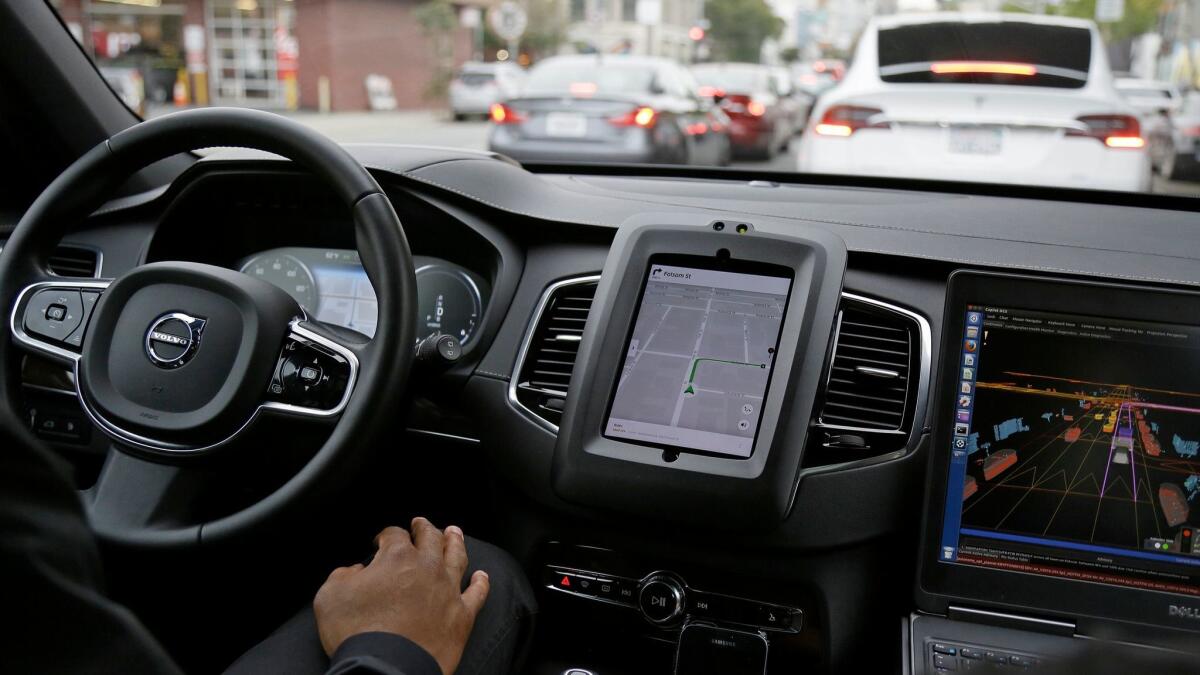Editorial: If Uber doesn’t like California’s rules, it can test its driverless cars elsewhere

- Share via
Uber is at it again. The company, famous (or notorious, depending on your point of view) for flouting regulations as it built its disruptive, multi-billion-dollar business, rolled out a fleet of autonomous cars in San Francisco this week despite an explicit warning from the Department of Motor Vehicles that testing on public roads was illegal without a permit.
Never mind that 20 of Uber’s competitors in the race to develop autonomous cars have followed the California DMV’s rules and gotten testing permits. Never mind that new federal guidelines for the safe operation of autonomous vehicles anticipate that car companies will get a state’s permission before testing driverless technology on its public roads. Never mind that Uber’s executives were told by DMV officials before the launch that the company would need a permit to operate its autonomous vehicles.
Instead, Uber — in typical Uber fashion — found an apparent loophole in California’s rules and chose to drive its driverless vehicles right through it. The regulations say a permit is required if the vehicle can drive itself “without the active physical control or monitoring of a natural person.” Defending the decision to forgo a permit, an Uber executive wrote in a blog post that “it’s still early days and the company’s cars are not yet ready to drive without a person monitoring them.”
Uber is setting up a false choice for cities and states. They can and should be pro-technology and pro-safety.
Of course they aren’t, but that’s not the point. No autonomous vehicle, including those covered by testing permits, can be driven in the state without a human monitor. The state requires that an operator sit behind the wheel during testing, ready to take control at any time. Why? Because the technology is unproven, and state regulators don’t believe it’s ready for uncontrolled operation on public streets — which is why California created, with industry input, a permitting process.
DMV officials didn’t buy Uber’s argument, nor should they have. Less than a day into Uber’s new venture, the DMV threatened legal action if the company didn’t halt testing. But Uber has refused to back down, insisting again on Friday that the “driverless” Ubers it has touted do not need permits because they are not really driverless, but rather vehicles equipped with advanced driver-assist technologies.
Uber built its business by challenging regulators and entrenched assumptions about how best to assure public safety. It successfully evaded the strict local rules that the taxi industry faces on fares, licenses and driver background checks by arguing that smartphone-summoned rides were different from taxis and should be regulated under new state standards. It has also avoided a variety of mandates on employers by classifying its drivers as independent contractors, not employees.
But c’mon, Uber — play by the rules this time. The DMV’s regulations are designed to prevent companies from using public streets as laboratories for risky experiments. The permit requirement for self-driving cars is no loophole to be exploited. This is about ensuring that an important, potentially transformative technology is rolled out in a safe and transparent fashion.
What’s especially frustrating is that Uber is blatantly ignoring one of the easiest, least controversial regulations facing autonomous vehicles. To get a testing permit, companies have to pay a $150 application fee, show proof of insurance and commit to submitting public reports detailing any crashes the vehicles have or instances when the human operator has to take control from the autonomous system. This is exactly the kind of information that regulators, the public and carmakers need in order to make informed decisions about the evolution and advancement of this technology.
Within Uber’s rebellion is a threat to California: The company has suggested it can easily take its innovation (and the jobs associated with it) elsewhere. Uber began testing its driverless service in Pittsburgh this fall with essentially no regulation and little oversight from city or state officials. The company said there are other “pro-technology” cities and states that are willing to open their roads for testing and deployment without the rules and requirements that could slow the development of driverless cars.
But Uber is setting up a false choice for cities and states. They can and should be pro-technology and pro-safety. If Uber doesn’t like the California DMV’s rules — which, admittedly, are a work in progress — it doesn’t have to test its cars here. But it can’t have it both ways. If it wants to gather data about its experimental cars on California’s streets, it should get a permit. Then it can address any objections it may have with the DMV while it works out the kinks in its technology.
Follow the Opinion section on Twitter @latimesopinion and Facebook
A cure for the common opinion
Get thought-provoking perspectives with our weekly newsletter.
You may occasionally receive promotional content from the Los Angeles Times.






